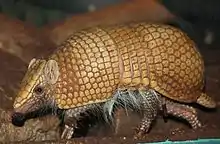xenarthran
English

A southern three-banded armadillo (Tolypeutes matacus), a xenarthran
Etymology
From Ancient Greek ξένος (xénos, “strange”) + ἄρθρον (árthron, “joint”).
Noun
xenarthran (plural xenarthrans)
- (zoology) Any mammal of the of superorder Xenarthra, of the Americas; an anteater, armadillo or sloth.
- 1978, Terry A. Vaughan, James M. Ryan, Nicholas J. Czaplewski, Mammalogy, page 355,
- Elephant-shrews, xenarthrans, hystricognathous rodents, cetaceans, some pinnipeds, and primates depart sharply from this trend, however.
- 2000, John F. Eisenberg, Kent H. Redford, Mammals of the Neotropics, Volume 3: Ecuador, Bolivia, Brazil, page 90,
- Xenarthrans appear to have originated in South America and to have undergone their major adaptive radiation there (Reig 1981).
- 2008, Christine Argot, 3: Changing Views in Paleontology: The Story of a Giant (Megatherium, Xenarthra), Eric J. Sargis, Marian Dagosto (editors), Mammalian Evolutionary Morphology: A Tribute to Frederick S. Szalay, page 37,
- Only four xenarthran families are extant today, providing little indication of the past richness of the order.
- 2010, Ana Maria Jansen, André Luiz Rodrigues Roque, 11: Domestic and Wild Mammalian Reservoirs, Jenny Telleria, Michel Tibayrenc, American Trypanosomiasis: Chagas Disease: One Hundred Years of Research, page 249,
- Marsupials and xenarthrans, which represented the autochthonous mammalian fauna, were T.[Trypanosoma] cruzi’s first hosts.
- 1978, Terry A. Vaughan, James M. Ryan, Nicholas J. Czaplewski, Mammalogy, page 355,
Usage notes
The xenarthrans were previously included within now obsolete (polyphyletic) order Edentata, along with aardvarks and pangolins.
Hypernyms
- (any species of Xenarthra): edentate (obsolete classification)
Hyponyms
- (any species of Xenarthra): anteater, armadillo, glyptodont, pampathere, sloth
This article is issued from Wiktionary. The text is licensed under Creative Commons - Attribution - Sharealike. Additional terms may apply for the media files.